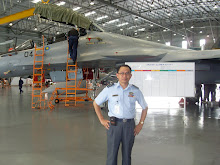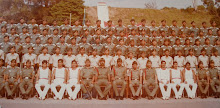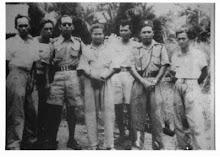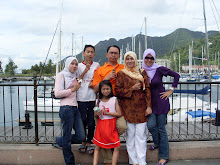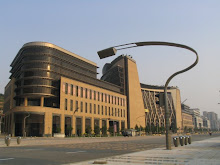After 2 years in Kuching, 3 years in Kuantan, 3 years in ITM and 2 years in MPPU.
My past 10 years service was not encouraging. Very low profile. My frustration of being 'lost my seniority' still annoying my mind. 4 years as a Lieutenant? Seeing my super-super juniors overtaken me getting their Captain rank. By the time I got my 'sub Capt' on 1 Aug 1989, it was already 7 months late. It was really demoralised me. My substantive Capt supposed to be on 24 Jan 1989. I lost my 7 months seniority (in Capt) unnecessarily. I thought the 'planner' already put me aside from the lane.
Upon graduating from ITM Shah Alam in Mei 1989, I was posted to Markas Pemerintahan Pertahanan Udara or MPPU (Air Defence Command HQ), which was located in KL Base. At that time, MPPU was the 'hottest plate' in the RMAF. Not because of the toughness of the works there but because of the Commander. The Commander (also the founder of MPPU) then was Brig Jen Datuk Abdul Ghani Aziz, the sit hot general and among the youngest general at that time. He was very 'up-to-date', sharp, intelligent, knowledgeable, tough, fit and active in rough outdoor sport (big bike, golf, marathon, equestrian, polo, mountain bike etc).

The legacy of Datuk Ghani (during his tenure as Panglima Pertahanan Udara) was the establishment of MPPU itself and he got his two star . However, he burried his own legacy in 1994 when he reorganised the whole RMAF structure. MPPU became No 1 Air Division HQ. His another legacy was 'Annual 10km Run'. Every year MPPU organised 'Jaguh Exercise' which involved all the fighter squadrons and air defence units. One of the events in this programme was 10km run. All officers were compulsoried to take part in this run. The entrance fees was RM100 (actually not a fee but a deposit). All must complete the 10km within 60 minutes. Every extra minute from 60 will be fined RM10. If you completed the run within one hour, you will get back your RM100, If you late 3 minute, you will get back your RM70. If you late by 10minutes, you will lose all. And after his retirement, this 10km run was also extinct.
I was officially posted out from Markas HANUD on 15 Dec 1991.
My tour in MPPU was about 2 and half years, before being called (interviewed) by Lt Col Ahmad Haidir (then SO1 SISLOG). He was looking for somebody to replace 'Mej Ahmad Zaini' (also my intake) as SO2 Training Finance in Training Directorate. Ahmad Zaini (nickname 'Short Neck') was posted to ITU Kinrara to assume 'Ketua Cawang Logistik' office and promoted to Major. He was among the TJP37 (my intake) got the rank of Major early. He deserved it.
After reviewing my profile and achievement, Col Haidir offered me to take over the SO2 Training/Finance without promotion (SO2 but Captain appointment). I accepted the challenge and by Dec 1991 I received the signal to report to MINDEF. Well, thank you Col Haidir, Sir. You found me in the mud, at last. I believe you did not regret with your choice and I am very sure, today, I will be proud with my achievement. I was oficially posted in to DTU-Latih on 15 Dec 91 but my reporting day was about 2 weeks after that.
In Training Directorate (LATIH), my Director of Training was Lt Col Mohd Yusof Abdul Kadir, an Engineering Officer. His face looked like a serious worker but he had a 'gentleman smile'. Handsome guy, supposed he has a 'mamak' blood.
Handling UK Training
Besides performing a duty of Budget and Financial roles in 'Latih', I had been given a task as a desk officer' for RMAF training programmes in UK and Jordan. Between 1992 to 1994, the activity of training in UK was very aggressive due to the implementation of 'MOU Project'. The MOU Project consist of the procurement package for 28 Hawk aircraft, Martello and MARDIS Radar System and Hawk Simulator System. Almost every month will be a group of RMAF officers and other ranks were going to UK either for long or short courses in various places in UK. I was really hectic dealing with MOU Project Office and also British High Comm from time to time. The most challenging works were late submission of candidates to the British due to English Test and also approval from 'Air Force Board'. The DA Office in British High Comm was always chasing me for the nomination. At that time, no hand phone and no email. Everything by facsimile or telephone.
My problems were actually RMAF problems. Another problem faced by this project was the 'perks' received by the trainee. I couldn't remember the amount of their substantive allowance in UK, but as low as they can only survive for a week in UK. The students/trainees were crying for shortage of money especially who ad married and left their family behind. Worst enough, some of them couldn't take the suffer/pressure and decided to give up the course and came back half way. My comment (today) is all those things showed the failure of the project team who did not thoroughly looked into this matter.
The Hawk project trainees were suffered. The problems were later brought up to the highest level in MINDEF and a new allowances were approved. The next group (Martelloo Course) were happier to stay in UK.
However, handling UK training gave me the opportunity to meet 'closer' the 'potential Chief of Air Force' , Kapt Ackbal Abdul Samad'. He was selected to go to UK for one year Test Pilot Course in ITPS, UK. The cost of the programme was very expensive, more than a million RM (in 1993). The allowance entitlement according to 'PMAT' (AFCI) was comparatively low because this course was not in the UKMTS (UK Military Training Scheme). Again, the Captain (SO 2) was given a task by the Director to deal with the ITPS to fight for some allowances for Ackbal. After number of negotiations, finally Ackbal would get additional 'perks' including house, car and some subsidiary above the alllowances from the official entitlements.
Eventhough I met Ackbal when I was in Pulatibang 3 Kuantan in 1984/85, we were not so closed because of his student life at that time. I had married, stayed in Quarters, and he was still bachelor, stayed in the Mess. After I left Kuantan in 1986, we lost contact.
Being so happy with the extra 'perks', before he left for UK, Ackbal came to me and made a promise "Toha, thank you very much for your efforts and assistance, I will never forget you, I will buy something for you when I come back from UK". I was not really 'taking note' of his promising words at that time. My principle of work (until today) is 'do your job, do not look for the rewards, if you are good, people will look for you'. So, we went to Ampang Park (he invited me to accompany him) to look for the luggage bag (the compliment from the travel agency). He got his Major in UK.
I knew the actual Ackbal one year later. The first day reporting to MINDEF upon completion of his course in ITPS, he ran to my office. I was doing the SO2 Personnel (SISMAT C) in Materiel Division (already a Major). Suddenly he appeared standing infront of me with a plastic bag and he said "Toha, as I promise to you, this is for you". A 'black leather jacket' which definitely I couldn't afford to buy at that time.
Who is Ackbal? He is now (1 Nov 2009) a Major General Ackbal. My PANGLIMA. See topic 'MLU and Tsunami)
Handling Jordan Training
Jordan was a newest country establishing a reciprocal training programme with the RMAF. That happened in 1992. It was started with the visit of 2 Colonels from RJAF to Malaysia. I had been given a task to present a briefing to them. The first programme was the exchange of Staff College student. Maj Syed Salim was selected as the first RMAF offices to go to Jordan.
However the RMAF was not really ready to receive the Jordanian counterpart (what I could remember, the name was Maj Mohammed Swaish al Sarhan. We supposed to provide a fully furnished quarters. In our entitlement, fully furnished is not included the TV, aircondition, carpet and refrigerator. So, just imagine, when he arrived, he claim all those items. So, as a desk officer, i got to rock every body to find this things.
The second programme was they offered RMAF for Fighter Weapon Instructor and we offered them F5 fighter conversion. The candidate from Jordan was Lt Feda'ee Khleif Ali. I could remember his name well because I was the one who taking care of his arrival, fetched him at the Subang Airport terminal. I brought him to my house in Shah Alam before sending him to Officers' Mess Subang because the next morning he got to have a courtesy call to my Director. He, the went to Kuantan for fighter conversion course (MB339A) before moved to Butterworth to fly F5.
Our candidate to Jordan was Kapt Amran Sulaiman TUDM from 12 Sqn, Butterworth. He went for Fighter Weapon Instructor Course in Jordan. The issue of Amran was, there was no allowances scale for Jordan in AFCI. So, we have to use the nearest rate, that was UK (based on the currency exchange rate: GBP1 = RM4). But the rate for short course was too small as what was faced by the trainees in UK. So, Amran was facing financial problem over there. We, in 'Latih' were not keeping quite. We work with our MINDEF and Treasury for the special rate for Amran. Finally, Treasury approved the special 'interim' rate for Jordan course, that was RM50 per day beside free accommodation and meal provided by the RJAF.
My short tenure in Training Directorate gave me really a great experience. Lt Col Yusof was also the one who guided me and gave me a trust to carry my job and recognised my performance. Later, i made to know that, he is a good friend to Lt Col Haidir. All my achievement was conveyed to Lt Col Haidir and by Mac 1993 I was recommended to get my Pay of Higher Rank (Major pay).
Dealing with financial control, I was assisted by one lady EO named Puan Wan Rokiah Wan Idris and my financial clerk was Puan Salina Yoong bt Abdullah. My SNCO was FSjn Sazali bin Abd Rahman.
Besides taking charge of Budget, Finance and Training Programme, I was also handling the ticketing office for training. The nice part of this job was, I had the opportunity to deal direct with all the Travel Agents. Just imagine, 95% of the the Marketing personnel for the agencies were female. So, almost every week I received a lady guesses. Actually, I got a lot more stories about this. Reserved.




































